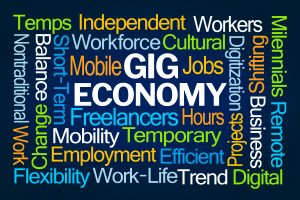
by admin | Jul 27, 2022 | Human Resources
 The United States, like some other countries around the world, including the United Kingdom and China, are facing an inflation crisis in this post-pandemic era. Inflation has great influence on Human Resources because it can cause the need for wage stagnation and budget cuts. The biggest disappointment during times of high inflation is the possibility of layoffs.
The United States, like some other countries around the world, including the United Kingdom and China, are facing an inflation crisis in this post-pandemic era. Inflation has great influence on Human Resources because it can cause the need for wage stagnation and budget cuts. The biggest disappointment during times of high inflation is the possibility of layoffs.
First, HR professionals should fully grasp inflation, which is the general rise in the prices of all consumer goods and services. The United States turns to the Consumer Price Index (CPI), which is measured by the U.S. Bureau of Labor Statistics, to gauge inflation, according to the Guardian. In fact, the United States is experiencing a 40-year high in inflation. Prices rose 8.5% year over year in March 2022.
Understand Inflation
There is no one root cause for inflation. Over the past few years, the world economy experienced a perfect storm that included a once-in-a-century pandemic and necessary stimulus, continuous lockdowns in China that have damaged supply chains, and a war in Europe between Ukraine and Russia that costs money to fight but is also hurting the world’s food and gas supplies.
In the United States, HR leaders are facing these challenges like everyone else. But they have one other issue with which to contend: the Great Resignation. (Some refer to it as the Great Reshuffle.) People are continuing to leave their jobs to seek better employee experiences, benefits, and compensation packages. In fact, 4.4 million people voluntarily quit, and companies doled out a record low 1.2 million layoffs in April 2022, according to CNBC. In addition, employers had 11.4 million job openings.
Some experts are saying it is the tightest job market on record. What seems like good news for the economy can actually mean that the country is headed for recession. If people have well-paying jobs and money to spend, demand goes up and so do prices. When this happens and supply is short, inflation skyrockets. Eventually, wages can not keep up with inflation, and people start cutting back on spending. Then, recession can begin.
Obviously, if the economy enters recession, companies will be tightening their belts. As a result, they may have to cut down on labor costs and do more with less. This often leads to layoffs and other budget cuts.
What’s Happening Now?
While some sectors, such as tourism, are bouncing back after the pandemic, others are slowing down. All those tech companies that earned boosts during the lockdowns saw drops in sales. Technology companies are already experiencing some hiccups in the job market. Uber, Microsoft, Twitter, Wayfair, Snap, and Meta (parent company of Facebook) are either slowing down hiring or putting hiring freezes in place. Netflix, Peloton, and Carvana laid off employees.
Still, these are the exceptions and not the rule. Most companies are still facing a shortage of labor, and unemployment remains historically low. Job candidates and employees have all the leverage despite concerns about a looming recession.
The Consequences
However, there are some signs that the tide may turn. First, the job market has to cool, which means fewer jobs can be available, for inflation to go down. Full employment, when everyone who wants a job has one, will make inflation rise. At some point, especially with gas and groceries costing as much as they do, individuals will not be able to walk away from jobs as easily. In addition, the companies will get leaner and do more with less, so they will stop hiring as much.
Some organizations have pumped up their hiring to meet the post-pandemic consumer demand, and they may then have to lay off their employees in response to a downturn in the economy. At that point, there may be another shift that gives leverage to the employer again. The question remains whether the transformation in treatment of employees, compensation and benefits, and work-life balance initiatives will endure in a recession.
If HR professionals must lay off their employees, they should have a plan and be kind. Those who have laid off people via Zoom or with harsh words have lived to regret it in the age of social media, when people share everything. Unfortunately, layoffs happen. It’s how HR leaders handle them that separates the professionals from the amateurs.
By Francesca Di Meglio
Originally posted on HR Exchange Network

by admin | Jun 20, 2022 | Human Resources
 U.S. President Joe Biden recently laid out his plans to combat inflation and the high cost of living. The average family is spending an additional $327 per month compared to pre-pandemic costs, according to a CNN broadcast May 10. At the time, the national average price of gas was $4.37. While the Federal Reserve can do more to influence inflation than the President, his announcement is welcome because people are suffering and some economists believe a recession is looming.
U.S. President Joe Biden recently laid out his plans to combat inflation and the high cost of living. The average family is spending an additional $327 per month compared to pre-pandemic costs, according to a CNN broadcast May 10. At the time, the national average price of gas was $4.37. While the Federal Reserve can do more to influence inflation than the President, his announcement is welcome because people are suffering and some economists believe a recession is looming.
Under normal circumstances, the economy can cause burdens for HR leaders. In this case, businesses are still confronting uncertainty that comes from an ongoing pandemic, war in Europe, and a labor shortage. This is not to mention a mental health crisis and increased obligations for employers when it comes to employee engagement and experience.
The first step in addressing the negative impact of the economy is being realistic about the current situation and understanding how it impacts HR:
Some Can’t Afford RTO
Many companies are finally deploying their return to office (RTO) plans from 2020. Employees and leadership are at odds, in many cases, about whether to return or continue to work from home. One of the arguments workers have about WFH is that it is cheaper.
Some employees are quitting because they cannot afford the commute or lunch costs that come with returning to the office. Childcare, which has always been a problem for working parents, is another huge expense. In some cases, people end up paying to work, and it becomes more affordable to quit. HR must keep this in mind when considering wages and salaries.
Compensation and Benefits Packages
During this time of historic labor shortage, HR leaders are reassessing their compensation and benefits packages because they want to be competitive. Employees have leverage and higher wages has been one of the most requested benefits for obvious reasons.
“The talent shortage has boosted pay, but not enough to keep up with inflation,” according to The New York Times. “Wages grew 5.6% in the last year.”
Another obstacle for HR professionals is that increasing offers for new hires ended up creating an uneven divide between them and their veteran counterparts. Now, in some cases, loyal employees who stayed with their employers are earning less than new hires. With this kind of inflation, they may be lured by the prospect of higher pay elsewhere, which could continue the cycle of the Great Resignation.
Budget Concerns
Money is obviously not going as far as it used to go. Therefore, HR professionals should worry that this economic reality could cause budget cuts. For now, 79% of corporate finance executives say their budgets will be larger in 2022 than in 2021, according to Billing Platforms annual 2022 Trends in Finance Survey. With inflation as high as it is, they should prepare for cuts at some point. This could mean fewer resources for learning and development, employee engagement and experience initiatives, compensation and benefits packages, and more.
Travel Constraints
At the moment, most headlines point to Americans’ desire to get back on the road and see people face to face for personal and professional meetings. However, with gas prices and inflation this high, many budget conscious employers may pull back on travel budgets.
The United States is also preparing to confront another surge in COVID-19 cases. RTO poses risks, especially for vulnerable employees with comorbodities or those who live with at-risk people. In addition, parents of children under 5, who are not yet eligible for vaccination, have expressed concerns about both RTO and having to travel for work.
Solutions
Every department in every business must face the reality of inflation and higher costs. HR is no exception. In the case of HR leaders, rising costs is a people problem. Employees will need more money to support their families and to make work valuable to them. In addition, the business itself will have to constrain spending in areas like travel and perks. Maybe those free lunches will have to stop.
Still, there are some solutions available to HR. Promoting people from within the company as opposed to hiring new employees is a way to save money and improve retention. Being transparent about the limitations on wage increases and offering other less expensive benefits to compensate are other ways to address the problem.
Of course, travel can be replaced with videoconferencing and digital events that can be conducted from home. HR leaders have had to stretch resources before and will certainly have to do it again in the future.
By Francesca Di Meglio
Originally posted on HR Exchange Network

by admin | Jul 2, 2019 | Benefit Management, Human Resources
 By now you’ve heard of the term “gig economy” but you may not know what it means. Is it describing the economy of musicians as they work gigs? Does it mean something about computers and the measurement of space allotted for their programs? Does it have something to do with fishing? Well, not exactly. But, have no fear! We will break this term down into easy bites and you’ll be an expert on the gig economy in no time.
By now you’ve heard of the term “gig economy” but you may not know what it means. Is it describing the economy of musicians as they work gigs? Does it mean something about computers and the measurement of space allotted for their programs? Does it have something to do with fishing? Well, not exactly. But, have no fear! We will break this term down into easy bites and you’ll be an expert on the gig economy in no time.
What IS the Gig Economy?
The term “gig economy” refers to the new landscape of employment in the world where workers are hired for temporary, flexible jobs instead of full-time permanent positions. Think of it this way: workers in a gig economy are paid for completing a job in a predetermined timeframe—like musicians are paid for a night of music (a gig) at a venue. In a gig economy, you see that independent contractors and freelancers tend to be hired over the more traditional, full-time job seekers. Examples of jobs that thrive in this economy are technology-based positions, creative jobs, and the new tide of service-based positions in companies like Uber, Airbnb, and Instacart.
Gig Economy Numbers
Forbes magazine reports that according to the 2018 numbers from the Bureau of Labor Statistics, there are 55 million people in the US classified as gig workers. This is a huge number! In fact, that translates to more than 35% of the current US workforce. Projected to rise to 42% in 2020, over 40% of these workers are estimated to be millennials. As those numbers increase, the proportion of male to female workers shifts. Once right at 50/50, the new ratio is 60/40. This is attributed to larger numbers of women returning to school for postsecondary education. In fact, many leave the workforce completely to return to school versus taking courses and working at the same time.
Pros of Gig Economy Jobs
There are many pros to a job in this category. Job seekers who are looking for gig economy positions name flexible workplaces and flexible hours as their top priorities. The shift to remote offices as well as the freedom to work at whatever hours are most convenient definitely supports this new economy. Employees who have the discipline to manage their workflow and complete tasks on time are ones that will thrive in a gig job. The positives are not limited to just the employees, though. Employers like being able to choose new hires from a much larger pool of candidates because they are not tied down to job seekers in their immediate vicinity. Employers are also able to save money as they do not have to invest in work equipment, health benefits, or on-going training for these independent workers.
Cons of Gig Economy Jobs
The cons of gig work are some of the flip sides to the pros of gig work. These drawbacks include the absence of health benefits and 401k benefits. Freelancers have to buy their own healthcare and figure out their own savings schedule for retirement—both of which aren’t impossible, but they do take up time and tend to be at a greater expense than the benefits offered in a traditional work environment. Gig workers also face the reality of no paid sick days or vacation days. If a freelancer has the flu, he isn’t paid for the time he misses from work and his deadline isn’t adjusted in this task-based economy. On the employer side of the equation, companies report that the pool of qualified candidates for higher level management positions continues to get smaller as the trend for gig workers who freelance from job-to-job increases
The workplace continues to evolve from a traditional 9-5 workday in a traditional office environment to one that is a flexible work cycle in an ever-changing location. Employees place high priority on setting their own rhythm for work flow and prize independence. Employers are encouraged to stay in-tune with the gig economy and to seek ways to marry their company’s needs with the needs of this new workforce population. Both employer and employee can benefit from this new work landscape.

 The United States, like some other countries around the world, including the United Kingdom and China, are facing an inflation crisis in this post-pandemic era. Inflation has great influence on Human Resources because it can cause the need for wage stagnation and budget cuts. The biggest disappointment during times of high inflation is the possibility of layoffs.
The United States, like some other countries around the world, including the United Kingdom and China, are facing an inflation crisis in this post-pandemic era. Inflation has great influence on Human Resources because it can cause the need for wage stagnation and budget cuts. The biggest disappointment during times of high inflation is the possibility of layoffs.

